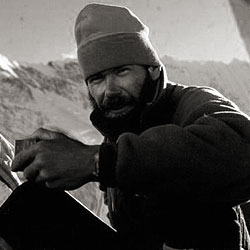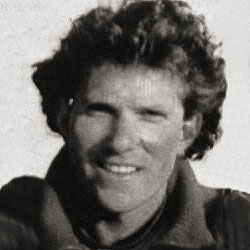
I n March of 1996, outside magazine sent Jon Krakauer, an experienced mountain climber and author, to write about and participate in a guided ascent of Mt. Everest. One of eight clients on an expedition led by world-renowned guide, Rob Hall. On May 10th Krakauer arrived at the summit, but it came at a terrible cost.
Four of Krakauer’s teammates who reached the top, including Hall, perished in a storm that blew in without warning. By the time Krakauer had descended to Base Camp nine climbers from four expeditions were dead, and three more lives would be lost before the month was out.
After spending weeks at Base Camp and making seven excursions to and from the higher camps in order to acclimatize, Krakauer and his team (Rob Hall, Mike Groom, Andy Harris, Frank Fischbeck, Doug Hansen, Stuart Hutchinson, Lou Kapische, Yasuko Namba, John Taske, and Beck Weathers) set out for the last time, in their attempt to reach the summit.
At one point in his life, Krakauer was an avid climber however in recent years, he has given up the hobby. When Outside magazine asks him to write an article about the commercialism on Everest, Krakauer knows immediately that he had to climb.
His expedition turns out to be the most deadly in Everest history. He successfully summits and leaves the mountain alive, but takes with him the story, and questions.
Krakauer attempts to figure out what went wrong and what happened to whom. He does extensive research and painstakingly traces the actions of every climber on the mountain. He theorizes about the breakdowns of the expedition, and attributes the disaster to a series of small mistakes.

The lead guide of Adventure Consultants, the Everest climbing service that guides Krakauer up the mountain. Hall began climbing in the Himalayas at age nineteen, and successfully climbed the highest mountain in each of the seven continents within a period of seven months. During the ascent he comes to the assistance of a number of climbers. Hall does not adhere to his own turn-around time for the summit. Hall, hours behind the turn-around time, waits for Doug Hansen, a current and former client. Hall had convinced Hansen to make another go at the summit, and despite running behind, Hall attempts to help him realize his dream. Hall and Hansen become stranded at the top of the mountain. Hansen runs out of oxygen, and Hall refuses to leave him. Hall’s loyalty is fierce, and he tries to protect his client until the very end.

A guide in Rob Hall’s expedition. He grows close to Krakauer during the climb. Krakauer holds himself accountable for Harris’s death. He comes to the assistance of anyone and everyone without hesitation, and eventually that same sense of loyalty turns out to be his downfall.
Harris’s death is one of the single biggest tragedies to unfold during the expedition. Harris and his girlfriend had just begun building a house, but he couldn’t resist the lure of the mountain. Always among the first to volunteer to do work or assist clients, Harris is one of the people Krakauer trusts throughout.

Weathers is a doctor who is obsessed with climbing. One of the more gut-wrenching aspects of the story is Weathers’ blindness that sets in at higher altitude. Weathers persuades Hall to let him attempt the summit, and promises that if he cannot sit he will wait for the next guide. After waiting hours for a guide, Weathers finally gets help down the mountain and joins the group that gets lost. During the rescue attempt, Weathers is left for dead with Namba. In a series of astounding feats of strength and spirit, Weathers stays alive. After being written off he eventually finds camp, ill and frostbitten. At camp, he is stripped of his sleeping bags in a fierce storm but lasts through the night. He also survives being brought down the mountain, finally seeing doctors at Base Camp who call his frostbite the worst they’ve ever seen.

About 100 pounds in weight, no more, she was twice that weight in determination. She was considered the most mentally focused and tough individual on the team. Though she was an enjoyable individual to be around she was also very quiet and reserved. Namba was a Japanese woman whose attempt to climb Everest gained much notoriety in Japan. Left for dead with Beck Weathers when their group gets lost on the way down the mountain. Unlike Weathers she cannot summon the strength to return to camp, and unfortunately dies. She didn’t have the body power to carry the same weight as easily as others on the team because of her small size. Also because of her small body mass, she got desperately cold much more quickly than the average climber.
A postal worker from Washington state who had been climbing for 12 years. Hansen turned back just 300 feet short of Everest’s summit the year prior to this expedition, in 1995. Hansen worked two jobs to afford his Everest expeditions. Hansen was easygoing, supportive, encouraging and a solid member of the team. He and Krakauer become close friends, as they had more in common with each other than with the other members on the team. Hansen is at the summit with Hall when the storm hits on May 10, 1996. Having ran out of supplemental oxygen and too exhausted to continue the descent, Hansen dies.
Climbing past Camps One and Two the team arrives at Camp Three. That night they begin using supplemental oxygen. Some climbers feel that using supplemental oxygen is tantamount to cheating. After a sleepless night they begin climbing toward Camp Four. It is crowded on the mountain—at least fifty people are ascending behind Krakauer.
Fixed rope lines are used to traverse a dangerous section known as the Death Zone, but at this time there are no ropes in place. Sherpas are sent ahead to take care of the ropes, but the lack of preparation slows the climbers and causes a traffic jam at 28,000ft.